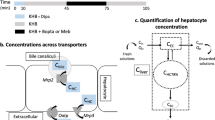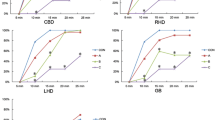Abstract
Mutant Wistar rats (TR− rats) are characterized by a defect in the canalicular transport system for organic anions in the hepatocytes. Anionic hepatobiliary contrast agents for X-ray and MR imaging usually depend on this transport system for biliary secretion. The current study investigated in rats whether Gd-EOB-DTPA, a hepatocyte-directed MR contrast agent, can be completely eliminated in the absence of biliary excretion, and whether urinary elimination may compensate for the hepatic dysfunction. In TR/t- rats elimination of Gd-EOB-DTPA almost completely depended on renal excretion: following intravenous administration of 25µmol kg−1 Gd-EOB-DTPA only 2.4±0.4% of the injected dose underwent biliary excretion. Nevertheless only 2% of a 10-fold higher dose (250µmolkg−1 Gd-EOB-DTPA) was still detected in the body 24 hours p.a., and less than 0.5% 7 days p.a. (no statistically significant differences as compared to values in control rats). In TR− rats, renal and liver signal intensities on T1-weighted MR images returned to baseline within 24 hours following administration of 25µmol kg−1 Gd-EOB-DTPA. In control rats, return to baseline values was observed already 6 hours after injection of the contrast agent. In conclusion, the hepatobiliary MR contrast agent Gd-EOB-DTPA is effectively and completely cleared from the body even in the virtual absence of biliary excretion. The urinary elimination pathway is able to fully compensate for the deficient hepatic transport system.
Similar content being viewed by others
References
Mühler A, Clement O, Vexler V, Berthezene Y, Rosenau W and Brasch RC (1992)Radiology 184 207–213.
Clement O, Mühler A, Vexler VS, Kuwatsuru R, Berthezene Y, Rosenau W and Brasch RC (1993)JMRI 3 71–77.
Clement O, Mühler A, Vexler V, Berthezene Y and Brasch RC (1992)Invest Radiol 27 612–619.
Schuhmann-Giampieri G, Schmitt-Willich H, Press WR, Negishi C and Weinmann H-J (1992) Preclinical evaluation of Gd-EOB-DTPA as a contrast agent in MR imaging of the hepatobiliary system.Radiology 183 59–64.
Weinmann H-J, Schuhmann-Giampieri G, Schmitt- Willich H, Vogler H, Frenzel T and Gries H (1991)Magn Res Med 22 222–228.
Jansen P (1987)Hepatology 7 71–76.
Oude Elferink RPJ, Ottenhoff R, Liefting W, Haan J and Jansen PLM (1989)J Clin Invest 84 476–483.
Oude Elferink RPJ, Haan Jd, Lambert KJ, Hagey LR, Hofmann AL and Jansen PLM (1989)Hepatology 9(6): 861–865.
Jansen PLM and Oude Elferink RPJ (1988)Seminars of Liver Disease 8 168–178.
Jansen PLM and Oude Elferink RPJ (1993) InHepatic transport and bile secretion: physiology and pathophysiology (N Tavoloni & PD Berg Eds) pp. 721–731. New York: Raven Press.
Arias IM, Che M, Gatmaitan A, Levelle C, Nishida T and Pierre MS (1993)Hepatology 17 318–329.
Klaassen CD and Watkins JB (1984)Pharmacol Reviews 36(1): 1–67.
Meijer DKF (1989) InHandbook of Physiology (SG Schultz, JG Forte, BB Rauner Eds) Bethesda, Maryland, USA: American Physiological Society.
Mühler A, Freise CE, Kuwatsuru R, Rosenau W, Liu T, Montorovitch J, Clement O, Vexler V, Mahboubi S, Lang P, Roberts JP and Brasch RC (1993)Radiology 186 139–146.
Clement O, Mühler A, Vexler VS, Rosenau W, Berthezene Y, Kuwatsuru R and Brasch RC (1992)Radiology 185 163–168.
Marchal G (1993) personal communication.
Rocklage SM, Quay SC and Worah D (1988)Diagn. Imaging Intern. Suppl Nov: 78–79.
Shaw D (1992) Mn-DPDP: clinical development of the first liver-specific MRI contrast agent.Third special topic seminar of the European Magnetic Resonance Forum: New developments in contrast agent research. Hamburg, Germany.
Grant D, Holtz E and Zech K (1993) Biodistribution and excretion of 54Mn and 14C labelled MnDPDP in rats and dogs (abstract).10th Annual Scientific Meeting of the ESMRMB Rome, Italy: p. 251.
Marchal G, Ni Y, Zhang X, Yu J, Lodemann KP and Baert AL (1993)J Comp Ass Tomogr 17(2): 290–296.
Lamirande E de and Plaa GL (1979)Toxic Appl Pharmacol 49 257–263.
Lamirande E de and Plaa GL (1978) Role of manganese, bilirubin and sulphobromophtalein in manganese-bilirubin cholestasis in rats.Proc Soc Exp Biol Med 158 283–287.
Vogl TJ, Pegios W, McMahon C, Balzer J, Waitzinger J, Pirovano G and Lissner J (1992)AJR 158 887–892.
Pirovano G, Lorusso V, Tirone P and Rosati G (1993)JMRI 3 155.
Author information
Authors and Affiliations
Rights and permissions
About this article
Cite this article
Muhler, A., Oude Elferink, R.P.J. & Weinmann, HJ. Complete elimination of the hepatobiliary mr contrast agent Gd-EOB-DTPA in hepatic dysfunction: An experimental study using transport-deficient, mutant rats. MAGMA 1, 134–139 (1993). https://doi.org/10.1007/BF01769415
Received:
Accepted:
Issue Date:
DOI: https://doi.org/10.1007/BF01769415




